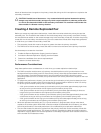9
Using The Remote Replication (Legacy)
Premium Feature
The Remote Replication (legacy) premium feature provides for online, real-time replication of data
between storage arrays over a remote distance. In the event of a disaster or a catastrophic failure on one
storage array, you can promote the second storage array to take over responsibility for computing
services. Remote Replication (legacy) is designed for extended storage environments in which the storage
arrays that are used for Remote Replication (legacy) are maintained at separate sites. Virtual disks on one
storage array are replicated to virtual disks on another storage array across a fabric SAN. Data transfers
can be synchronous or asynchronous. You choose the method when you set up the remote replicated
pair. The data transfers occur at Fibre Channel speeds to maintain data on the different storage arrays.
Because Remote Replication (legacy) is storage based, it does not require any server overhead or
application overhead.
You can use Remote Replication (legacy) for these functions:
Disaster
recovery
Remote Replication (legacy) lets you replicate data from one site to another site,
which provides an exact duplicate at the remote (secondary) site. If the primary site
fails, you can use replicated data at the remote site for failover and recovery. You
can then shift storage operations to the remote site for continued operation of all
of the services that are usually provided by the primary site.
Data vaulting
and data
availability
Remote Replication (legacy) lets you send data off site where it can be protected.
You can then use the off-site copy for testing or to act as a source for a full backup
to avoid interrupting operations at the primary site.
Two-way data
protection
Remote Replication (legacy) provides the ability to have two storage arrays back up
each other by duplicating critical virtual disks on each storage array to virtual disks
on the other storage array. This action lets each storage array recover data from
the other storage array in the event of any service interruptions.
How Remote Replication (Legacy) Works
When you create a remote replicated pair, the remote replicated pair consists of a primary virtual disk on
a local storage array and a secondary virtual disk on a storage array at another site. A standard virtual disk
might only be included in one replicated virtual disk pair.
The primary virtual disk is the virtual disk that accepts host I/O activity and stores application data. When
the replication relationship is first created, data from the primary virtual disk is copied in its entirety to the
secondary virtual disk. This process is known as a full synchronization and is directed by the RAID
controller module owner of the primary virtual disk. During a full synchronization, the primary virtual disk
remains fully accessible for all normal I/O operations.
97


















